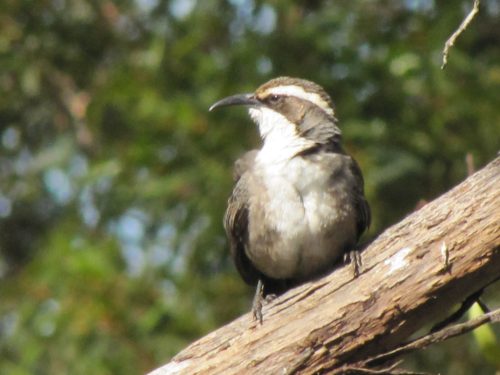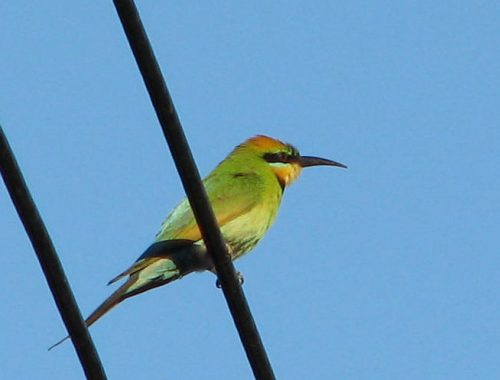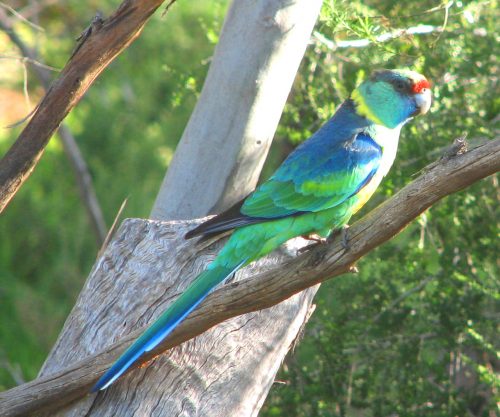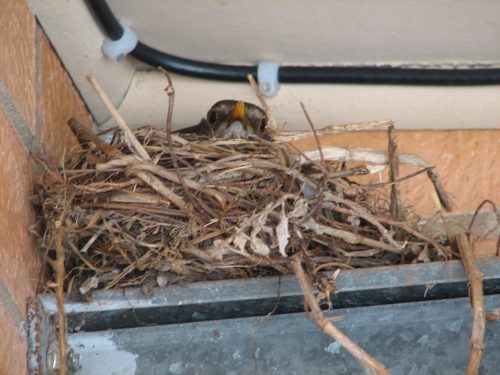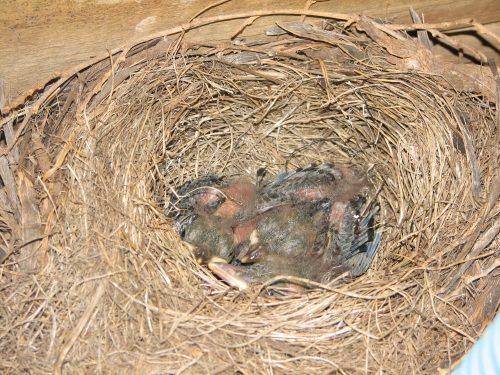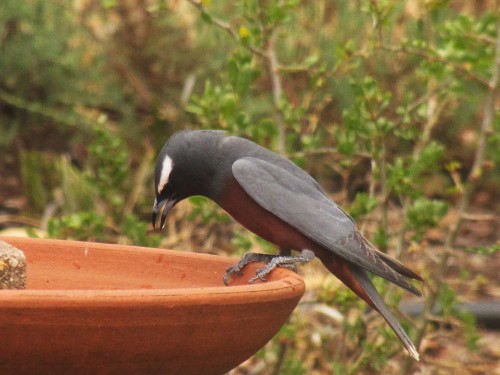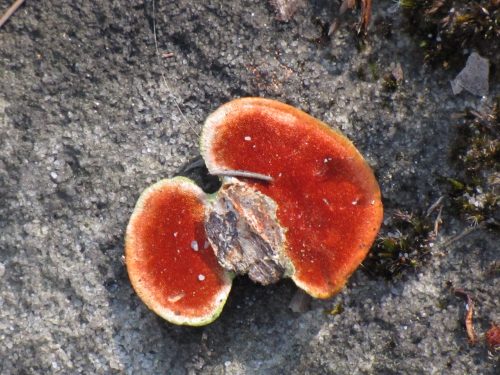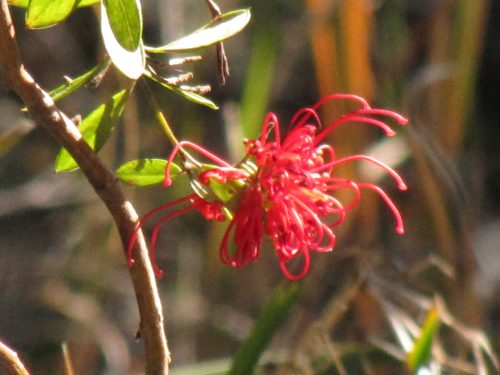Bird visitors at my window
Over recent days we have had both hot weather and lovely weather. This is normal for mid-summer days here in South Australia. For any new readers, I live about 80km or an hour’s drive south-east of Adelaide. Summer temperatures are usually in the high 20s or low 30s (30C is equal to 86F). During our worst summer days, temperatures can soar as high as 45C (113F), but thankfully such days only occur a few times every year.
Over recent weeks, many days have been in the mid-20s, which is very pleasant. On such days I love to open the large window next to my writing desk and let the fresh air into my office. If there is a breeze as well, that is an added bonus. One of the side benefits of this arrangement is the easy access to the bird life in our garden. I don’t even have to get up out of my chair to watch the birds. They come to me.
One one occasion, a friendly Australian Magpie (see photo above) sat on the rail of the pergola on this side of the house. He was in full view from where I sat. He suddenly stopped his carolling – our magpies are wonderful songsters – realised I was there and leant forward to get a better view of me. When I chatted with him, thanking him for the visit and the song, he answered me. How lovely.
On several occasions over the last week, one or two Peaceful Doves have alighted in the branches of a nearby tree, coo-ing persistently for about ten or fifteen minutes before moving on elsewhere in our garden. Their soft calls are very peaceful, so they are aptly named.
Only yesterday I had to stop what I was writing and look out to the garden bed next to my office window. A small family of White-browed Babblers were playing around in the bushes there, scolding each other as they scurried here and there. They were joined in this game by several New Holland Honeyeaters, their screeches usually a warning sign that a hawk or eagle is about. I think they were just having fun with the babblers. Even a couple of House Sparrows joined in the fun.
One species we don’t always have around is the Rainbow Bee-eaters, a delightfully named bird with their many-coloured plumage and their liking for catching and eating bees and other flying insects. I smile when I see one sitting in a nearby tree, banging a bee against the branch to dispatch the sting of the bee before swallowing it whole. Yesterday two or three could be heard out of my window while I worked, and later I saw two gliding overhead. Delightful birds, and we miss them when they fly north for the winter.
For many years we never had wrens resident in our garden. They were only occasional visitors from up the hill. Then five years ago on our return from an overseas trip, we were greeted by two Superb Fairy-wrens, one of two local species. They have been a resident breeding species in our garden ever since, producing several broods over those five years. They are so secretive about their nests that I have yet to find one. They have plenty of good bushes around to build their nests. From time to time they will also come by my office, their twittering, tinkling calls easy on the ears as they hop along near my office window, jumping up occasionally to snatch a fly or mosquito silly enough to hang around too long.
I don’t need to have the window open to hear our resident Mallee Ringneck parrots screeching outside as they fly from tree to tree, or over the house, or just sitting in a nearby tree wagging their tails joyfully. This tail wagging is probably a mating display. They have raised several broods successfully in recent years, their nest hollow being only 30 metres from my window.
What birds do you have in your garden?
Please tell me in the comments.
Good birding,
Trevor
A story about Blackbirds, Honeyeaters and Cats
Common Blackbirds
Nearly 11 years ago, I wrote a simple little article on this blog about Common Blackbirds (click to read).
Never did I imagine that it would be so popular. It consistently is one of the ten most read articles on this site, and with nearly 300 comments from readers, it has obviously struck a chord with my readers.
A few days ago, one of my readers – Sue – wrote a wonderful account of the Common Blackbirds in her garden, along with comments on honeyeaters and their interactions with her pet cats. I found this account so fascinating that I have published it here in full so that more readers can enjoy her experiences.
Hi Trevor,
Great massive Blackbird thread!
I thought I would add our Blackbird experience for your consideration.We have a medium-sized block in Kensington, Adelaide, so I have a bit of garden surrounding the old villa. We have two cats, which live entirely inside with the amenity of a professionally built, fully netted enclosure on one side of the house from verandah to fence.
The honeyeaters were the first to find a way into the enclosure, by dropping through the ceiling netting which has a slightly larger grid than the wall netting, to get to the citrus trees inside. They were always faster than the one cat who has any real hunting ability. Their other advantage is that cat is deaf – so if he doesn’t see them, he doesn’t know they are there.
Then the resident pair of blackbirds learnt the same trick. For them the strip of garden along the fence and the mulched area around the compost bins are a rich source of forage. They are also faster than the cats. And they also enter and exit at speed, despite the bird seeming too large for the net.
The enclosure has vine growing over it. The vine is trained underneath on wires, and grows up through the net.
Honeyeaters chose to nest in the vine above the net. They raised a chick, then moved to the bamboo for the next round.This summer the blackbirds have built a nest in the vine IN the enclosure, UNDER the net. They fledged one enormous chick just before Christmas and to our delight have gone another round with two, possibly three, hungry chicks being fed as I type.
We were worried how the baby might get out safely, but we actually saw it fledge over a weekend. It was encouraged out of the nest, to hop around the branches, then encouraged up through the net. We have seen it in the rest of the garden with its parents several times.Mrs B doesn’t worry even when I am watering right under her. Previous behaviour for the blackbirds, the honeyeaters and even the wattlebirds is to nag me in the garden for the rain wave sprinkler then enjoy the ‘rain’. It’s not just Aussie humans that like running under the sprinkler in the hot weather.
This year the rosellas have the small hole in an old peppercorn tree, and the lorikeets had the large hole in the same tree, and were both successful.
The rest of the garden is not cat free, and there are definitely cats, rats, foxes, as well as possums and the annual koala, using it at times, but the complexity of the cat enclosure and the presence of the cats seems to keep the (non-resident) predators away from it.
In a highly artificial urban environment, we would all prefer if native species could thrive, but sometimes the imports are better suited to holding a niche. Compared to mynahs, the blackbirds seem to be a lesser of two evils. And lorikeets have proved to be pretty dominating over the smaller rosella..
Happy bird encounters, all… Sue
Thank you, Sue, for a wonderful description of the birdlife and wildlife in your suburban garden. I wish more cat lovers would be as responsible as you are with a special enclosure.
Happy birding,
Trevor
Further reading:
- Common Blackbirds – the article which started it all
- Do Blackbirds swoop? How to deal with aggressive bird behaviour – another article with over 100 comments from around the world.
- Keep your cats inside – an article I wrote some time ago about the problem of cats to the Australian environment.
- Great birding moments #7 Koala
Happy Christmas
HAPPY CHRISTMAS to all of my readers.
I watched the news this evening and saw that terrible weather conditions are being experienced by many people around the world. From storms, heavy rain, blizzards, to deep snow and heat waves. Our own South Australian capital city, Adelaide, had the highest temperature of all the cities of the world: 41.3C (106F). I live only 80km south east of Adelaide and it was very hot here too – around the same temperature; it may have just touched 42 for a while. Except for a trip to church early in morning, I stayed indoors in air-conditioned comfort. Thankfully, cooler weather and rain is forecast for later in the week.
Birds in hot weather
Yesterday I wrote about the importance of regularly providing fresh water for the birds in your garden, especially in the type of hot weather we experience in summer here in Australia. They really appreciate it, and this provides opportunities for the avid birder to watch them through a nearby window without disturbing them in any way.
Because of the hot weather, I was reluctant to get out and about. Despite the heat, I was aware of some of the species outside. Some of our birds have loud calls, and we had a very quiet Christmas with no visitors. Several times I heard Peaceful Doves calling, and there was the persistent call of a baby Red Wattlebird just out of the nest. Through one of our windows I saw our resident Willie Wagtails a few times, and this evening, when I briefly braved the elements, I disturbed a small flock of Galahs from one of our trees.
The resident Australian Magpies came frequently for a drink at the bird bath, and earlier this morning I observed a loose flock of about 25 Little Ravens flying overhead. The resident House Sparrows kept in the shade for most of the day, coming to the water in the birdbaths frequently. We usually hear the noisy and gregarious New Holland Honeyeaters, but they were rather subdued today. So were the Spiny-cheeked Honeyeaters and the White-plumed Honeyeaters. I also briefly heard the small family of Superb Fairy-wrens which occupy the bushy parts of our property.
I just checked the weather radar; there are storms on the way. Tomorrow I must get outside a few times and keep a look out for Swifts; just their kind of conditions.
Once the weather cools a little, I hope to get out and about a few times. It is about time I took some more photos to share here.
In the meantime, I hope that you have a wonderful Christmas wherever you are, and whatever the weather.
Good birding,
Trevor
Give the birds a drink
It has been a year of great weather contrasts this year in South Australia, and in other parts of the country too. At various times it has been freezing cold, fiery hot, bucketing with rain, wild storms and everything in between. We have also had the occasional beautiful day as well. Our state has had terrible bushfires, devastating floods, power blackouts from storms, crop damage due to large hail and silently creeping frosts.
Now we are about to feel the full force of summer weather. Christmas Day tomorrow promises temperatures in the low 40s (40C = 104F). In fact. our capital city Adelaide is forecast to be the hottest capital city in the world on Christmas Day. Still, at this time of the year, we expect some days in the 40s and many days in the 30s.
Heat and birds
The heat can adversely affect our birdlife here in Australia. One of the best things people can do in these hot conditions is to put out clean water for the birds. I have several birdbaths dedicated to the birds in our garden. A constant stream of birds come to have a bath or a drink on hot days. Even on mild days, the bowls are very popular.
Place the bird bath in a shady location near to a tree or bush. This can help protect the smaller species from birds of prey; it gives them a place to escape. It can be on the ground but is better if it is elevated a little. This will give the birds a clear view of any approaching cats.
Try to remember to clean the bird bath regularly, and during our hot weather this summer, top it up every day.
Photography
I have found over many years that having a bird bath near a window makes it easy to get good photographs of the birds while they are drinking or bathing. My wife and I find it very relaxing sitting in a cool room on a hot day, watching the parade of birds coming to drink.
Further reading:
- Time for a bath – a list of birds and animals we have observed at our bird baths
- The importance of bird baths – another article about bird baths
Good birding,
Trevor
Ku Ring Gai Wildflower Gardens – more than flowers
Yesterday I wrote about a visit to the Ku Ring Gai Wildflower Garden in St Ives in northern Sydney earlier this year. On that occasion, we were annoyed by a rather pesky Australian Brush Turkey which thought it had a right to some of our afternoon tea. It went away disappointed.
These gardens are a nature lover’s delight. Not only is there a good number and variety of birds present, but one can wander along the many walking and cycling tracks throughout the park, enjoying nature up close. As we were having our snack we were delighted to see a Swamp Wallaby carrying a joey in its pouch (see photo below). This was a real delight for our five-year-old grand-daughter.
Many other items intrigued our grand-daughter as she clambered through the bush with her grandmother. The fungi shown below held her attention for a while, not mean feat because she is always on the go.
She was also interested in the many flowers in bloom along the walking tracks. Knowing that her grandmother was interested in the flowers, she would race ahead, pointing out the new plant in bloom. She often became frustrated when we stopped too long to take photos of the flowers. Some of these are shown below.


